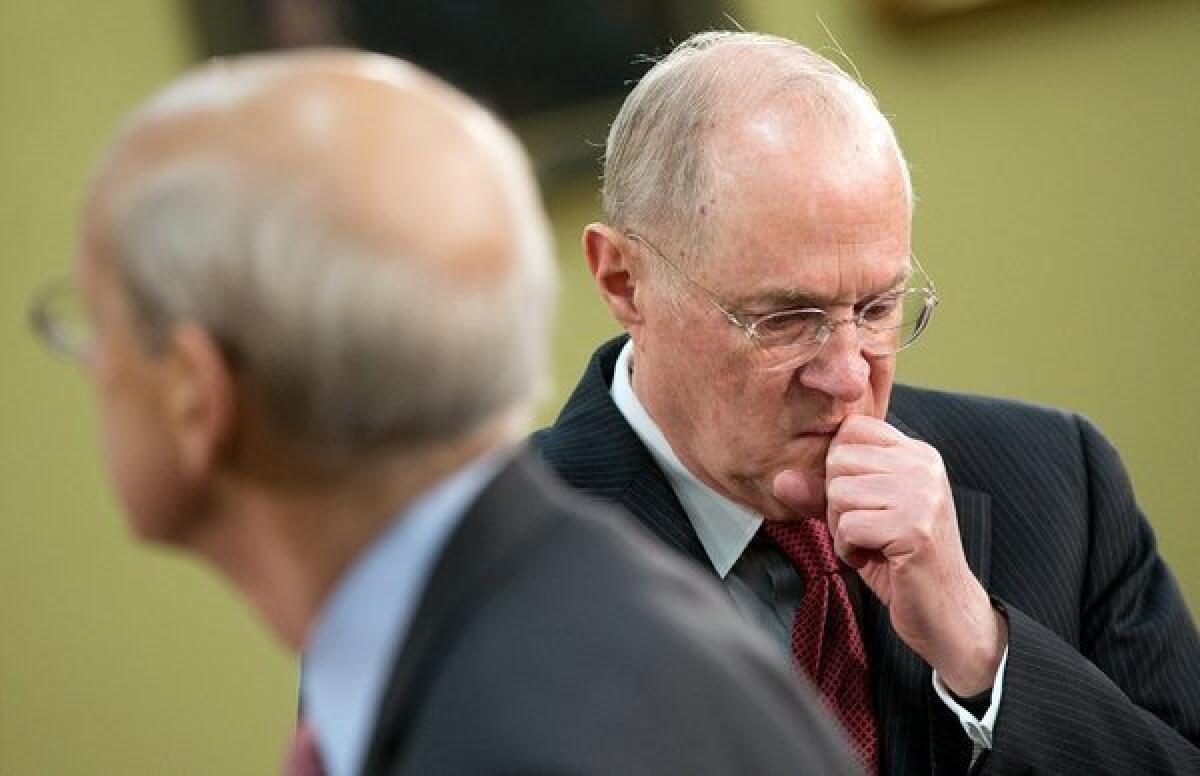A hint that affirmative action may survive

- Share via
All but eclipsed by the speculation about how the Supreme Court will rule on same-sex marriage is the fact that the court will also hand down a decision in the next few months about the constitutionality of affirmative action at state universities. But even if the court rules that the University of Texas went too far in seeking to assemble a racially diverse class, that may not mean the end of racial preferences.
These are tough times for supporters of affirmative action. Some states, including California, have adopted prohibitions of racial preferences in college admission and government programs. An influential book coauthored by a UCLA law professor argues that racial preferences at elite institutions create a mismatch between the students who benefit from such preferences and the institutions they attend -- meaning that some flunk out who would have completed their studies at less demanding schools. Finally, only 10 years after the Supreme Court ruled that state universities could take race into account in admissions decisions, the court seems poised to rein in such preferences in a case involving the University of Texas.
But reports of the imminent death of affirmative action may be exaggerated. And one piece of evidence for that theory is that the court recently agreed to hear an affirmative action case from Michigan that raises a different issue from the one in the Texas case.
The issue in the Texas case is whether the University of Texas improperly took race into account in the second phase of its admissions process. In the first phase, students who finished in the top 10% of their high school classes were automatically accepted, an approach that (because so many Texas high schools are largely black or Latino) produced a good deal of racial diversity. But, once those slots were filled, the university took race into account in assembling the rest of the class, partly to ensure that there was “diversity within diversity” -- that is, that some of the minority freshmen came from affluent school districts where they might not have finished in the top 10%.
This notion wasn’t very appealing to Justice Anthony M. Kennedy, a possible swing vote. “You want underprivileged of a certain race and privileged of a certain race,” he told the university’s lawyer. “So that’s race.” And race in itself is a harder sell for the Supreme Court than race as a proxy for certain life experiences.
Kennedy dissented in 2003 when the court upheld a racial preference at the University of Michigan Law School. But he is not as dead set against the use of race as some of his conservative colleagues. So one possibility is that he would rule that, having already achieved significant racial (and economic) diversity with its Top 10 plan, the university wasn’t free to use racial preferences at the second stage of the admissions process. If he votes that way, it could leave intact (barely) the 2003 University of Michigan precedent allowing schools without a Top 10 system to consider race as “one factor” from the start.
Last week the court agreed to hear the state of Michigan’s appeal of a federal appeals court decision striking down a ballot measure barring preferential treatment by state universities and state and local government on the basis of race, sex, color, ethnicity or national origin. That proposal had been championed by Ward Connerly, the former University of California regent who had helped persuade voters here to approve a similar measure, Proposition 209, in 1996. Whereas the Texas case raises the question of whether the Constitution allows a state university to consider race, the Michigan case poses the different question of whether a state’s voters may order the university not to do so.
The betting was always that a majority of the court, including Kennedy, would reverse the U.S. 6th Circuit Court of Appeals and reinstate Michigan’s ban on racial preferences. The surprise, as Times reporter David Savage noted, was that the justices announced that they would hear the appeal before they ruled on the Texas case.
Does this mean that the majority is heading toward reaffirming that state universities may, under some circumstances, voluntarily consider race in their admissions decisions? If so, the four conservative justices who would have been outvoted on that question may now be looking to the next battle.
ALSO:
How not to say the wrong thing
More to Read
A cure for the common opinion
Get thought-provoking perspectives with our weekly newsletter.
You may occasionally receive promotional content from the Los Angeles Times.










